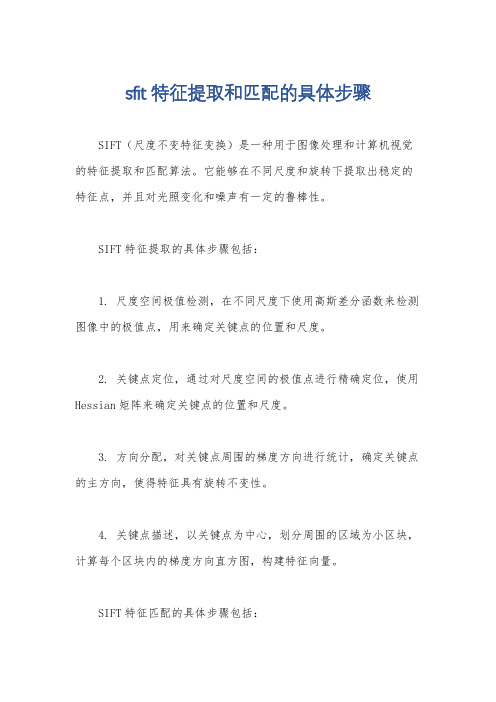计算机视觉特征检测和匹配
计算机视觉的基本流程

计算机视觉的基本流程
计算机视觉是一种模拟人类视觉的技术,它通过算法和数学模型来使计算机识别和理解图像或视频中的对象和场景。
计算机视觉的基本流程包括以下步骤:
1. 图像采集:计算机视觉的第一步是获取图像或视频。
这可能涉及到使用摄像机、扫描仪或其他设备来捕捉图像或视频。
2. 图像处理:图像或视频采集后,需要进行预处理。
这可能包括降噪、增强图像对比度等操作,以便更好地提取有用信息。
3. 特征提取:接下来,需要从图像或视频中提取关键特征。
这可能包括物体的形状、大小、颜色、纹理等信息。
4. 特征匹配:在识别物体时,需要将提取的特征与已知物体的特征进行匹配。
这可能涉及到使用匹配算法,如SIFT、SURF等。
5. 目标检测:一旦特征匹配成功,就可以进行目标检测。
这可能涉及到使用机器学习算法,如支持向量机(SVM)等。
6. 目标跟踪:如果目标在图像或视频中移动,需要进行目标跟踪。
这可能涉及到使用滤波器、卡尔曼滤波器等算法。
7. 目标识别:最后一步是识别目标。
这可能涉及到使用神经网络、深度学习等算法。
总之,计算机视觉的基本流程包括图像采集、图像处理、特征提取、特征匹配、目标检测、目标跟踪和目标识别。
这些步骤通常需要进行多次迭代,以不断提高计算机视觉的准确性和效率。
- 1 -。
了解计算机视觉技术中的特征匹配算法

了解计算机视觉技术中的特征匹配算法计算机视觉技术是一门研究如何使计算机能够通过摄像头等设备获取、分析和理解图像信息的学科,而特征匹配算法是计算机视觉技术中的一项重要技术之一。
本文将详细介绍特征匹配算法的原理、应用和发展趋势。
特征匹配算法是指通过提取图像中的特征点,并将这些特征点与数据库中的特征点进行匹配,从而实现图像识别、目标跟踪、三维重建等任务的一种算法。
它的核心思想是通过计算特征点之间的相似性度量值,找到最佳匹配,从而确定图像之间的对应关系。
特征匹配算法主要采用以下步骤:特征提取、特征描述和特征匹配。
首先,特征提取阶段利用一些局部图像特性的检测器(如尺度不变特征变换(SIFT)、加速稳健特征(ASIFT)等)从图像中提取关键点。
然后,在特征描述阶段,算法会为每个关键点生成一个向量,该向量包含关键点附近的图像内容信息。
最后,在特征匹配阶段,算法会将图像中的特征点与数据库中的特征点进行匹配,并计算相似性度量值,以确定最佳匹配。
特征匹配算法在计算机视觉领域中有广泛的应用。
其中,图像检索是最常见的应用之一。
通过利用特征匹配算法,用户可以通过输入一张查询图像,从庞大的图像数据库中快速找到与之相似的图像。
此外,特征匹配算法还可以用于目标跟踪、三维重建、运动估计等领域。
然而,特征匹配算法也面临一些挑战和问题。
首先,图像中的噪声、光照变化和视角变化等因素会干扰特征提取和匹配过程,降低算法的准确性。
其次,当图像中存在大量特征点或者特征点之间存在相似性很高的情况时,算法的匹配效果也会受到影响。
最后,特征匹配算法在大规模图像数据库中的应用仍然面临计算效率的挑战。
针对这些问题,研究者们提出了许多改进的特征匹配算法。
例如,对于光照和视角变化问题,可以使用尺度不变特征变换(SIFT)算法,该算法对图像缩放和旋转具有较好的不变性。
对于大规模图像数据库的匹配问题,可以采用基于局部二进制模式(LBP)的加速稳健特征(ASIFT)算法,该算法可以提高匹配的效率。
BRISK特征点检测匹配算法的探究

BRISK特征点检测匹配算法的探究BRISK(Binary Robust Invariant Scalable Keypoints)特征点检测算法是一种用于计算机视觉领域的关键点检测和匹配的算法。
它在快速特征点检测和匹配方面表现出色,同时保持了很强的稳健性。
本文将探讨BRISK算法的原理、流程以及应用,并讨论其在图像处理领域的重要性。
BRISK算法的原理是基于二进制描述符的尺度不变性的。
它使用了一种基于样本比较和像素对比的方法来检测图像中的关键点。
该算法首先在图像中提取角点,然后对这些角点进行描述符计算,最后通过描述符的匹配来实现特征点的匹配。
BRISK算法的优点在于其对旋转、尺度和亮度变化有很好的鲁棒性,可以在图像中检测到各种实际场景下的关键点。
1.对图像进行预处理:将RGB图像转换为灰度图像,并进行高斯平滑处理。
2. 提取角点:使用FAST算法或Harris角点检测器提取图像中的角点。
3.计算描述符:在每个角点周围采样一些采样点,计算这些采样点的灰度值和周围像素的对比情况。
4.特征匹配:对每个检测到的关键点,通过描述符的比较来进行特征点匹配。
在BRISK算法中,描述符的计算是其核心部分。
描述符通常是一个二进制字符串,用于表示特征点周围的像素对比情况。
在BRISK中,描述符的计算通过对周围像素的样本点进行对比来实现。
这种方法具有很好的尺度不变性和鲁棒性,能够在各种环境下准确地匹配特征点。
BRISK算法在图像处理领域有着广泛的应用。
它可以用于目标跟踪、图像拼接、三维重建等不同领域。
在目标跟踪中,BRISK算法可以用于检测目标物体在不同帧之间的位置变化,实现目标的跟踪和定位。
在图像拼接中,BRISK算法可以用于寻找不同图像中相似的特征点,从而实现图像的拼接。
在三维重建中,BRISK算法可以用于检测图像中的特征点,从而实现对物体的三维重建。
总的来说,BRISK算法是一种性能优越的特征点检测和匹配算法,具有很好的尺度不变性和稳健性。
特征匹配的三个步骤

特征匹配的三个步骤特征匹配是一种常用的图像处理和计算机视觉领域的技术,它可以通过比较图像中的特征点来找出两幅图像之间的相似性。
特征匹配的三个步骤包括特征提取、特征描述和特征匹配。
一、特征提取特征提取是特征匹配的第一步,它的目标是从图像中提取出最具代表性的特征点。
常用的特征点包括角点、边缘点和斑点等。
在进行特征提取时,需要考虑到图像中的噪声和变形等因素,选择合适的特征提取算法。
在特征提取的过程中,一种常用的方法是使用Harris角点检测算法。
该算法通过计算图像中每个像素点的角点响应函数来识别角点。
角点是图像中灰度变化最大的点,具有较高的信息量和稳定性。
二、特征描述特征描述是特征匹配的第二步,它的目标是对提取出的特征点进行描述,将其转换为具有可比性的特征向量。
常用的特征描述算法包括SIFT(尺度不变特征变换)、SURF(加速稳健特征)和ORB (Oriented FAST and Rotated BRIEF)等。
在特征描述的过程中,SIFT算法是一种经典的方法。
它通过对特征点周围的局部区域进行尺度空间的变换和高斯模糊处理,得到特征点的尺度不变描述子。
这种描述子具有旋转不变性和尺度不变性,能够更好地描述特征点的特征。
三、特征匹配特征匹配是特征匹配的最后一步,它的目标是找出两幅图像中具有相似特征的特征点对。
特征匹配可以通过计算特征向量之间的相似度来实现,常用的相似度度量方法包括欧氏距离、汉明距离和余弦相似度等。
在特征匹配的过程中,一种常用的方法是使用最近邻法。
该方法将待匹配图像中的每个特征点与参考图像中的特征点进行比较,选择距离最近的特征点作为匹配点。
通过设定一个阈值来判断匹配点的可靠性,可以过滤掉不可靠的匹配点。
特征匹配是一种通过比较图像中的特征点来找出两幅图像之间的相似性的技术。
它包括特征提取、特征描述和特征匹配三个步骤。
特征匹配在图像处理和计算机视觉领域有着广泛的应用,如图像拼接、目标跟踪和图像检索等。
特征匹配算法

特征匹配算法
1 特征匹配算法
特征匹配算法是计算机视觉技术的一种将特征描述子在两个图像中做排序,并返回匹配点的数学工具。
它是一种可以用来解决图像的广泛的和可靠的运动跟踪,定位和图像检索等问题的技术。
特征匹配算法在当今广泛应用,尤其在运动估计,对象跟踪,图像建模,图像内容提取等方面有着重要的研究价值。
它可以用来快速和有效地检测特征点,有助于在图像上定位特征,并通过计算机视觉算法来验证匹配点是否有效。
2 特征匹配算法的工作流程
特征匹配算法的工作流程包括特征检测,特征描述子的提取,特征的比对,匹配点的筛选和最终的匹配结果的验证等几个步骤。
1.特征检测:根据输入图片中特征点的空间分布,基本特征量,形状,结构等特点,使用特征检测算法检测出图片中的特征。
2.特征描述子的提取:在从图片中检测出的特征的基础上,使用特征描述子的提取算法提取每个特征的特征描述子。
3.特征的比对:将不同图片中提取出的特征描述子进行比较,以定位出特征之间的短暂的有效的匹配点。
4.匹配点的筛选:框定出有效的匹配点,去除不准确的匹配点,最终得到实用的匹配结果。
5.匹配结果验证:使用人工或计算机视觉算法计算得到的有效的匹配结果,并进行验证,来作最终的确认。
3 结论
特征匹配算法是一种用于计算机视觉技术的数学工具,其工作流程分为特征检测,特征描述子的提取,特征的比对,匹配点的筛选,最终的匹配结果的验证等几步。
它在当今有着重要的应用价值,可以被用于运动估计,对象跟踪,图像建模,图像内容提取等方面,以及图像的快速定位,建立高质量的匹配结果等方面,能够节省大量的时间和经验。
pythonopencv3基于ORB的特征检测和BF暴力匹配knn匹配flann匹配

pythonopencv3基于ORB的特征检测和BF暴力匹配knn匹配flann匹配Python OpenCV3中的ORB特征检测和BF暴力匹配以及FLANN匹配是计算机视觉中常用的技术,用于在图像中寻找相似的特征点并进行匹配。
下面将详细介绍这些技术以及如何使用它们。
一、ORB特征检测ORB(Oriented FAST and Rotated BRIEF)是一种用于检测图像特征的算法。
它结合了FAST特征检测和BRIEF特征描述子,并对其进行了改进,以便在实时性和准确性之间取得较好的平衡。
使用OpenCV中的ORB特征检测算法需要使用以下步骤:1. 创建ORB对象:使用cv2.ORB_create(方法创建ORB对象。
3. 绘制特征点:使用cv2.drawKeypoints(方法绘制特征点,传入原始图像、特征点和输出图像。
二、BF暴力匹配BF(Brute-Force)暴力匹配是一种简单但较慢的特征点匹配算法。
它通过计算两组特征点之间的欧氏距离,找到距离最近的特征点对。
使用BF暴力匹配算法需要使用以下步骤:1. 创建BFMatcher对象:使用cv2.BFMatcher_create(方法创建BFMatcher对象。
2. 匹配特征点:调用BFMatcher对象的match(方法,传入两组特征描述子,方法将返回最佳匹配的特征点对。
3. 绘制匹配结果:使用cv2.drawMatches(方法绘制匹配结果,传入原始图像和两组特征点。
三、FLANN匹配FLANN(Fast Approximate Nearest Neighbors)是一种快速近似最近邻算法,它可以在大型数据集上进行高效的最近邻。
在图像匹配中,它可以加速特征点匹配的过程。
使用FLANN匹配算法需要使用以下步骤:1. 创建FLANN匹配器:使用cv2.FlannBasedMatcher(方法创建FLANN匹配器对象。
2. 创建索引:调用BFMatcher对象的knnMatch(方法,传入两组特征描述子和最近邻数k,方法将返回最佳匹配的特征点对。
图像特征检测与匹配方法研究综述

图像特征检测与匹配方法研究综述图像特征检测与匹配是计算机视觉领域的重要研究方向,它在许多实际应用中发挥着关键作用,如图像检索、目标识别和三维重建等。
本文对图像特征检测与匹配方法进行综述,主要包括特征检测算法、特征描述算法和特征匹配算法三个方面。
一、特征检测算法特征检测算法旨在寻找图像中的稳定不变性特征点,以便用于后续的特征描述和匹配。
常用的特征检测算法包括Harris角点检测算法、SIFT 算法和SURF算法等。
1. Harris角点检测算法:该算法通过计算图像的局部灰度变化,寻找具有最大角度变化的像素。
它能够有效检测出图像中的角点,但对于尺度变化和旋转不变性较差。
2.SIFT算法:SIFT算法通过构建高斯金字塔和尺度空间极值检测,寻找出图像中的尺度不变的关键点。
同时,通过计算局部图像的梯度方向直方图,生成特征向量描述子,实现图像的匹配。
3. SURF算法:SURF算法是SIFT算法的改进版本,采用了一种快速的积分图像技术,大大提高了计算效率。
SURF算法在计算图像的尺度空间极值点时,使用了一种基于Hessian矩阵的指标,检测出更加稳定的特征点。
二、特征描述算法特征描述算法利用特征点周围的图像信息,生成唯一且具有区分度的特征向量。
常用的特征描述算法有SIFT描述子、SURF描述子和ORB描述子等。
1.SIFT描述子:SIFT描述子通过计算特征点周围的梯度信息,生成128维的特征向量。
它具有较强的区分度和旋转不变性,在图像匹配任务中表现较好。
2. SURF描述子:SURF描述子是一种基于Haar小波特征的描述子,使用了一种积分图像计算方法,降低了计算复杂度。
SURF描述子的维度为64维,具有良好的尺度不变性和旋转不变性。
3.ORB描述子:ORB描述子是一种快速的二值描述子,基于FAST角点检测算法和BRIEF描述子。
它既具有较快的计算速度,又能够保持较好的特征区分度,适用于实时图像处理任务。
三、特征匹配算法特征匹配算法的目标是在不同图像中找到相互匹配的特征点对。
sfit特征提取和匹配的具体步骤

sfit特征提取和匹配的具体步骤
SIFT(尺度不变特征变换)是一种用于图像处理和计算机视觉的特征提取和匹配算法。
它能够在不同尺度和旋转下提取出稳定的特征点,并且对光照变化和噪声有一定的鲁棒性。
SIFT特征提取的具体步骤包括:
1. 尺度空间极值检测,在不同尺度下使用高斯差分函数来检测图像中的极值点,用来确定关键点的位置和尺度。
2. 关键点定位,通过对尺度空间的极值点进行精确定位,使用Hessian矩阵来确定关键点的位置和尺度。
3. 方向分配,对关键点周围的梯度方向进行统计,确定关键点的主方向,使得特征具有旋转不变性。
4. 关键点描述,以关键点为中心,划分周围的区域为小区块,计算每个区块内的梯度方向直方图,构建特征向量。
SIFT特征匹配的具体步骤包括:
1. 特征点匹配,使用特征向量的距离来进行特征点的匹配,通常使用欧氏距离或者近邻算法进行匹配。
2. 鲁棒性检验,对匹配点进行鲁棒性检验,例如RANSAC算法可以剔除错误匹配点,提高匹配的准确性。
3. 匹配结果筛选,根据匹配点的特征向量距离或一致性进行筛选,得到最终的匹配结果。
总的来说,SIFT特征提取和匹配的具体步骤包括特征点检测、定位、描述以及匹配过程。
这些步骤能够帮助我们在图像处理和计算机视觉中提取出稳定的特征并进行准确的匹配,从而实现目标识别、图像配准等应用。
- 1、下载文档前请自行甄别文档内容的完整性,平台不提供额外的编辑、内容补充、找答案等附加服务。
- 2、"仅部分预览"的文档,不可在线预览部分如存在完整性等问题,可反馈申请退款(可完整预览的文档不适用该条件!)。
- 3、如文档侵犯您的权益,请联系客服反馈,我们会尽快为您处理(人工客服工作时间:9:00-18:30)。
•Find corresponding pairs
•Use these pairs to align images
Matching with Features
• Problem 1:
– Detect the same point independently in both images
E (u, v) u, v u M v
• Describe a point in terms of eigenvalues of M: measure of corner response
R 12 k 1 2
2
• A good (corner) point should have a large intensity change in all directions, i.e. R should be large positive
direction of the slowest change
Selecting Good Features
1 and 2 are large
Selecting Good Features
large 1, small 2
Selecting Good Features
small 1, small 2
Harris Detector: Mathematics
2
• R depends only on eigenvalues of M • R is large for a corner
“Edge”
R<0
“Corner”
• R is negative with large magnitude for an edge
Matching with Features
•Detect feature points in both images
Matching with Features
•Detect feature points in both images
•Find corresponding pairs
Matching with Features
I x2 M w( x, y ) x, y IxI y
IxI y 2 Iy
M is also called “structure tensor”
Harris Detector: Mathematics
Intensity change in shifting window: eigenvalue analysis
More motivation…
• Feature points are used also for:
– – – – – – – Image alignment (homography, fundamental matrix) 3D reconstruction Motion tracking Object recognition Indexing and database retrieval Robot navigation … other
directions
1 and 2 are small; E is almost
constant in all directions
“Flat” region
“Edge” 1 >> 2 1
Harris Detector: Mathematics
Measure of corner response:
Selecting Good Features
• What’s a ―good feature‖?
– Satisfies brightness constancy—looks the same in both images – Has sufficient texture variation – Does not have too much texture variation – Corresponds to a ―real‖ surface patch—see below:
R det M k does not requires computing the eigenvalues.
det M 12 trace M 1 2
(k – empirical constant, k = 0.04-0.06)
Can nail it
5
Building a Panorama
M. Brown and D. G. Lowe. Recognising Panoramas. ICCV
How do we build a panorama?
• We need to match (align) images • Global methods sensitive to occlusion, lighting, parallax effects. So look for local features that match well. • How would you do it by eye?
Harris Detector: Workflow
Harris Detector: Workflow
Compute corner response R
Harris Detector: Workflow
Find points with large corner response: R>threshold
x, y
2
Window function
Shifted intensity
Intensity
Window function w(x,y) = 1 in window, 0 outside
or Gaussian
Taylor series approx to shifted image
Harris Detector: Mathematics
no chance to match!
We need a repeatable detector
Matching with Features
• Problem 2:
– For each point correctly recognize the corresponding one
?
We need a reliable and distinctive descriptor
Harris Detector: Workflow
Take only the points of local maxima of R
Harris Detector: Workflow
Harris Detector: Summary
• Average intensity change in direction [u,v] can be expressed as a bilinear form:
Harris Detector: Basic Idea
“flat” region: no change as shift window in all directions
“edge”: no change as shift window along the edge direction
“corner”: significant change as shift window in all directions
Harris Detector: Mathematics
Classification of image points using eigenvalues of M: 2 “Edge” 2 >> 1
“Corner” 1 and 2 are large, 1 ~ 2; E increases in all
Bad feature Left eye view Good feature Right eye view
– Does not deform too much over time
Contents
• Harris Corner Detector – Overview – Analysis • Detectors – Rotation invariant – Scale invariant – Affine invariant • Descriptors – Rotation invariant – Scale invariant – Affine invariant
• |R| is small for a flat region
R>0
“Flat” |R| small
“Edge” R<0 1
Harris Detector
• The Algorithm:
– Find points with large corner response function R (R > threshold) – Take the points of local maxima of R
E (u, v) u, v
u M v
1, 2 – eigenvalues of M
direction of the fastest change
Ellipse E(u,v) = const
Iso-intensity contour of E(u,v) (max)-1/2 (min)-1/2
An introductory example: Harris corner detector
C.Harris, M.Stephens. “A Combined Corner and Edge Detector”. 1988
The Basic Idea
• We should easily localize the point by looking through a small window • Shifting a window in any direction should give a large change in intensity
